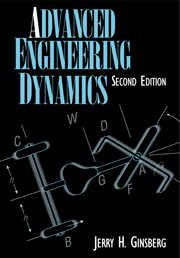Book contents
- Frontmatter
- Contents
- Preface
- Chapter 1 Basic Considerations
- Chapter 2 Particle Kinematics
- Chapter 3 Relative Motion
- Chapter 4 Kinematics of Rigid Bodies
- Chapter 5 Newtonian Kinetics of a Rigid Body
- Chapter 6 Introduction to Analytical Mechanics
- Chapter 7 Further Concepts in Analytical Mechanics
- Chapter 8 Gyroscopic Effects
- Appendix Centroidal Inertia Properties
- Answers to Even-Numbered Problems
- Index
Chapter 6 - Introduction to Analytical Mechanics
Published online by Cambridge University Press: 05 June 2012
- Frontmatter
- Contents
- Preface
- Chapter 1 Basic Considerations
- Chapter 2 Particle Kinematics
- Chapter 3 Relative Motion
- Chapter 4 Kinematics of Rigid Bodies
- Chapter 5 Newtonian Kinetics of a Rigid Body
- Chapter 6 Introduction to Analytical Mechanics
- Chapter 7 Further Concepts in Analytical Mechanics
- Chapter 8 Gyroscopic Effects
- Appendix Centroidal Inertia Properties
- Answers to Even-Numbered Problems
- Index
Summary
The constraints imposed on the motion of a system enter the Newton–Euler formulation of the equations of motion in two ways. The kinematical relations must account for the restrictions imposed on the motion, while the kinetics principles must account for the reaction force (or moment) associated with each constraint. When the system consists of more than one body, the need to account individually for the constraints associated with each connection substantially enhances the level of difficulty.
The Lagrangian formulation we shall develop in this chapter takes a different view of systems. The principles are based on an overview of the system and its mechanical energy (kinetic and potential). In contrast, the Newtonian equations of motion are time derivatives of momentum principles. Another, and perhaps the most important, difference is that the reactions exerted by supports will usually not appear in the Lagrangian formulation. This is a consequence of the fact that the reactions and the geometrical description of the system are two manifestations of the same physical feature. It is from the kinematical perspective that we shall begin our study.
Generalized Coordinates and Degrees of Freedom
Suppose the reference location of a system is given. (Such a location might be the starting position or the static equilibrium position.) We must select a set of geometrical parameters whose value uniquely defines a new position of the system relative to the initial position.
Information
- Type
- Chapter
- Information
- Advanced Engineering Dynamics , pp. 245 - 308Publisher: Cambridge University PressPrint publication year: 1995
